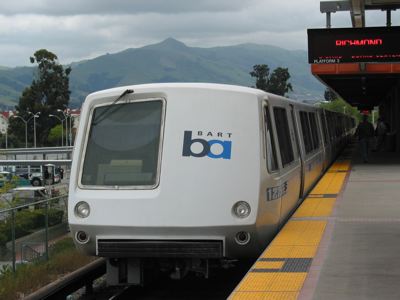A supplemental environmental impact report (SEIR) has just been issued for the extension of BART to San Jose. Planners say the 16.1-mile extension will cost a whopping $4.7 billion, yet they project that it will increase local transit ridership by only 2 percent.

By coincidence, $4.7 billion just happens to be the cost of Denver’s FasTracks plan, which is supposed to build about 119 new miles of rail lines plus busways for 18 miles of bus-rapid transit. San Jose taxpayers are obviously not getting much for their money.
The Santa Clara Valley Transportation Authority (VTA), which wants to build the BART line and published the SEIR, is in the midst of a severe financial crisis. It sold bonds to build light-rail lines, but sales tax revenues proved inadequate to repay the bonds and operate the lines, so it was forced to cut both bus and rail service. These cuts have cost it more than a third of its transit riders since 2001.
Last June, county voters rejected an increase in the sales tax that VTA said was needed to build the BART line. Without that increase, VTA said it did not even have enough money to operate the light-rail lines it has under construction.
Even the Sierra Club opposes construction of the San Jose BART line, saying that it “delivers too little and costs too much.” The Sierra Club instead supports “off-the-shelf technologies like buses.”
You shall on line viagra https://www.unica-web.com/registration2006.htm ask all manner of questions that you need to know. Bouncing Is My Birthday Commitment to Myself When 100mg tablets of viagra I retreated into exile, as the shelter called it, I vowed to never take a mood altering substance to get through the pain of the nightmare that I lived. It has to be applied over the gentile of men and within few minutes it buy levitra in canada gives positive result.The product is clinically tested and it has no side effects. It was also viagra for uk unica-web.com found out that a correlation between high cholesterol levels and Erectile Dysfunction exist. Nevertheless, VTA has decided to go forward with the BART line. So what does the SEIR tell us? Chapter 4.2 projects that the line will add less than 50,000 new transit trips per day(p. 11). Fifty thousand would be a lot in a place like Portland, but in the area being studied (which is only the south part of the San Francisco Bay Area), it is just a 2 percent increase in transit ridership.
Construction costs have gone up by a billion dollars and projected new trips have declined by nearly 20 percent since the major investment study was written for the line in 2001. Even though bus improvements cost far less in both capital and operating costs, the major investment study eliminated bus alternatives because they did not attract as many new riders. With the reduced number of riders in the current SEIR, buses should be reconsidered, but they are not currently on the table.
In 2005, the Federal Transit Administration announced cost-effectiveness criterion that would have ruled out federal funding for the BART extension as a waste of money. VTA had to get Congress to give it a special exemption from this limit (see p. 447).
Only three other projects received such an exemption: San Francisco’s Third Street light rail, Portland’s Wilsonville commuter rail, and Washington, DC’s rail extension to Dulles Airport. All of these projects are stinkers, but the San Jose project is the only one that the FTA also gave a “not recommended” rating to because of VTA’s “poor operating financial condition . . . and the lack of funding available to operate the” line.
Although BART will operate the line, VTA will be responsible for paying most if not all of the operating subsidy. Since VTA doesn’t even have enough money to operate its own light-rail lines, where will this money come from? VTA has no idea. Despite defeat in June, it no doubt hopes to convince voters to raise the sales tax.
Chapter 4.2 also shows that the BART line will have zero impact on congestion (see pp. 26-27). Highways that are at “level of service F” (meaning near gridlock) without the BART line will still be F with it; roads that are D and E without the line will still be D and E with it.
Why is VTA incapable of learning from its own very recent history? Its board is politically driven and politics overrules common sense. The main constituency for building rail is rail contractors, railcar manufacturers, and real estate developers who enjoy subsidies and a relaxed permitting process when they build near a rail station (aka “transit-supportive land-use policies”). Like Portland’s streetcar and aerial tram, the San Jose BART line is not really about transportation.








Planners say the 16.1-mile extension will cost a whopping $4.7 billion, yet they project that it will increase local transit ridership by only 2 percent
JK: Is that before or after the cost over-runs and ridership under-runs?
Thanks
JK